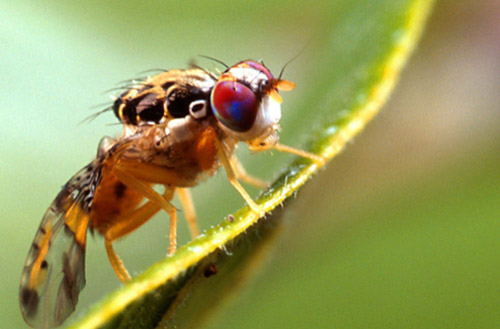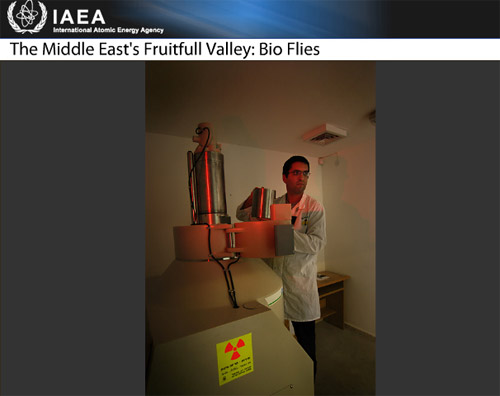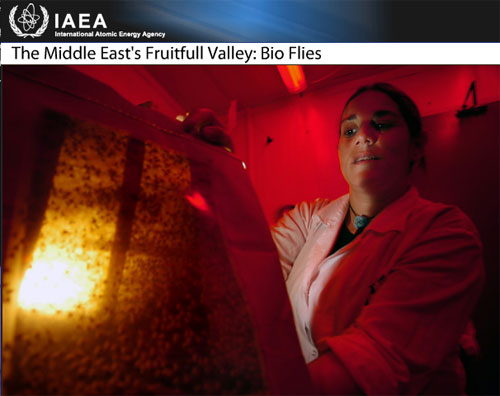The curse of the medfly and its eradication

The Medfly: a curse for fruit plants
A little known application of radioactivity in the food processing industry, is the eradication of harmful insects, like the Mediterranean fruit fly- the Medfly – in countries producing fruits and vegetables. Left to multiply naturally, these flies attack the lemon tree plantations and other fruits. The females attack the ripening fruit leaving their eggs inside.
© Scott Bauer/USDA (United States Department of Agriculture)
The Mediterranean flies or Medflies are a dreadful curse for the fruit tree plantations in hot countries. Left to their natural multiplication, these flies are capable to attack all sorts of fruits like lemons, apples, peaches, pears as well as vegetables (tomatoes, peppers, avocado).

Sterilization of males pupae
Fly larvae such as silkworms, lock themselves in a cocoon to take their final form. Still in the pupae stage and during this transformation, the future cocoons containing male flies are irradiated to be made sterile. These flies are irradiated in Israel, but remarkable example of cooperation in a troubled Middle East, some of them will be scattered over orchards in Jordan.
© AIEA – Biofly/Ilan Misrahi
The International Atomic Energy Agency, (IAEA) has joined up with the FAO to overcome this curse that not only affects the countries of the Mediterranean but also all fruit producing regions like California, Mexico, Guatemala, Chili and Argentina. The technique is that of the Sterile Insect Technique (SIT). It consists of breeding the male flies that are sterilized by radiation before being released in nature.
This technique controls the birth of wild female offspring, which leads to a notable decrease in the population as far as extinction. SIT has been used in the fight for the eradication of many dangerous insects on each continent. In particular, the butcher fly, that attacks cattle, the tsetse fly and the Mediterranean fruit fly (Ceratitis capitata) or Medfly.

Aerial release
This specially equipped aircraft is loaded with a shipment of 7 million flies that will be spread over the Arava valley between Israel and Jordan. The plane dives low to disperse the sterile males above the villages, kibbutzim and cultures – all of which are potential hot spots for Medfly infestation. Air release is effective but relatively expensive. Small planes criss-cross precisely the target area, with GPS, and the flies are released from the plane by a computer-controlled device.
© AIEA – Biofly/Ilan Misrahi
In the case of the Mediterranean fly, the life cycle of the fly is spread across a month. The female attacks the fruit during ripening, leaving hundreds of eggs after piercing the skin. In three days they hatch as starved Larvae. The maggots devour the juice and ruin the harvest. The larvae become young flies which grow to become a new generation.
Starting from a strain of genetically modified flies, experts are able to raise only the male flies having eliminated the female eggs more sensitive to temperature levels.

Manual release
A bag of 7000 Mediterranean flies made sterile at the BioFly plant of the Beit Shean Kibbutz in Israel. The plant incubates and rears male flies sterilized by irradiation before being released into the wild. These sterile male flies placed in these bags will be released by hand on the ground to reach areas not reached by the path of aerial releases. These bags loaded onto a truck, will be torn apart every 100 m in the treatment area.
© AIEA – Biofly/Ilan Misrahi
The Larvae become nymphs. The chrysalises are subjected to radiations, guaranteeing that no fertile fly is left in the nature. At this stage the male cocoons are transferred to a hatching installation. They must be able to fly, and have enough energy to find free female partners and live long enough to pair up.
The releases usually take place in the air, but they can also be on land. Most of the programs have as an aim to let go 20 to 100 times more sterile males than wild males with whom the are competing. If there are enough of them sterile, mating results in a rapid reduction leading to the extinction of the curse to the great benefit of fruit, the prosperity of producers and the health of consumers.
Other articles on the subject « Applications of Radioactivity »
Inspection and controls
A tool for testing and tune-ups The penetrating property of radiations is commonly used to check [...]
Material Developmnent
Improvements in the quality of industrial products Every day we make use of products that have be[...]
Non Destructive Testing
Control of industrial processes and materials Tracers and radioactive sources are frequently used[...]
Food processing
Eradicate bacteria, fungi and pests with radiation … Gamma rays are used industrially to en[...]
Food Preservation
Conservation and preservation of food The effects of radiation on the cells of living or vegetabl[...]
Conservation Effects
A conservation process without additives, non radioactive The biological effects of strong doses [...]
Disinfecting Effects
Getting rid of parasites and germs….. The radiobiological action of radiation leads to damage to [...]
Radioactive Gauges
Instruments for industrial process control In order to be peforming and efficient; modern industr[...]
Sources in Industry
A wide variety of applications Most radioelements in radioactive sources are extracted from small[...]
Various Applications
Because of the fears it inspires, radioactivity is considered in the collective unconscious as ho[...]